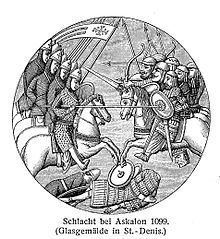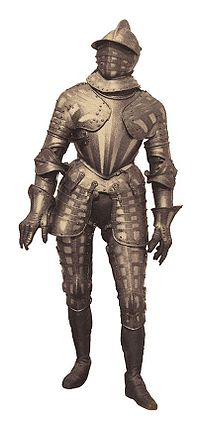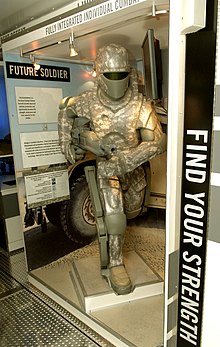armor
When armor is called a historical protective clothing that their support primarily against weapons exposure to protect against and wounding. Armor has been in use for thousands of years and was made from a wide variety of materials and using different methods. The most widespread armor in the European Middle Ages was made of textile ( gambeson ). The best armor available was a warrior's protection , made of rings ( chain armor ) or, from the late Middle Ages , of metal plates ( plate armor ) for the chest ( armor ), neck ( hulls ), arms (bracers, gauntlets ) and legs (greaves, iron shoe ) . Even today, armor is still worn in various areas, including the police and the military ( bullet-resistant vests ). The helmet , probably the most important part of armor, is examined in its own article. The shield , although it was the most important protective equipment for most fighters, does not count as armor.
Animals used in combat ( fighting dogs , battle horses , war elephants ) were also partially protected by armor. The knight's horse wore pieces of armor such as horse foreheads , foreheads, loin armor and the like for protection .
Armor types
Examples of prehistoric, ancient, medieval and early modern armor:
- Textile armor , gambeson
- Leather armor
- Bell armor
- Flap armor
- Muscle armor
- Armor
- Lamellar armor
- Scale armor
- Chain armor
- Rail or clasp armor
- Brigantine
- Record skirt
- Plate armor
- Piercing and racing gear
- Japanese armor ( Yoroi )
- Step armor made of silk ( Mongolian warfare )
Especially since the late Middle Ages , plate armor that was suitable for a specific use emerged, see: Types of plate armor .
Protective clothing , which is usually made of special fibers such as Kevlar , hard plastic or ceramics, is also used today .
History and Development
Oldest forms
All the beginnings of armor draw on natural products. Tree bark, hide or bones and horn parts of the hunted prey were used. The further development of the armor aimed at increasing the strength, paired with greater freedom of movement. This was achieved by duplicating the individual layers of the material, by reinforcing it using horn, wood or metal plates, by placing the scales next to and on top of each other, as well as armor made of belt and cord mesh, individual rods, etc. Finally, metal was used. There is evidence of these early forms of armor in the form of finds or faithful replicas in museums.
Some of these oldest forms of armor can still be found among indigenous peoples in the recent past.
- Tree bark armor with horn scales at the Bugi on Sulawesi . Beautifully decorated tree bark armor in the shape of wide belts, which were tied very tightly around the waist, were common in New Guinea.
- Cotton war skirts from African regions Gourma , Dagomba and Mossi in Northern Togo with sewn-on, tightly lined up, very sturdy leather bags.
- In earlier times there were cotton armor in America ( Aztecs etc.), but also in central Sudan ; made of rattan
- Braided armor is worn on the north coast of New Guinea , armor made of coconut fiber is worn on the Gilbert Islands .
- Rod armor In a more primitive replica of these Japanese armor made of rods and discs of walrus teeth, bones, wood, etc., caused by the scarce resources available, the peoples of Northeast Asia and North America used to wrap themselves up .
- Fur cuirasses were common in equatorial Africa from Albert Nyanza to Shari .
Tanks of the Tlingit -Indianer from wood or bone plates and rods
Armor made from natural materials of a warrior from the Micronesian island of Nauru
Antiquity
Assyrian and Chaldean soldiers were already wearing them as early as 710 BC. A shirt-like armor whose metal scales were sewn onto buffalo skin. The lightly armed men had protection up to the waist. For the heavily armed soldiers, it covered the neck and upper arm and reached down to the feet. Greaves covered the front of the leg to the knee. In Egypt, in addition to leather armor, which were often reinforced with wide metal bands (breast splints), armored shirts made of bronze scales from 20 to 25 cm in size as well as bracers and greaves made of bronze were found around 1000 BC. BC before. Such scale armor was also used by the Parthians , Persians and Sarmatians and spread from them all over the Orient . The Greeks contributed by this time bronze chest and back tanks, each forged in one piece or consisting of tile-shaped sliding plates, as well as leg rails ( Knemiden ) on both legs, equal to the Etruscans .
Among the Romans , the Velites (lightly armed infantry) wore the greaves ( ocreae ) on the left, like the Samnites and their modeled gladiators , the heavily armed ones ( Hastati ) on the right, the leg in front of them during combat . The scale armor ( Lorica Squamata or Lorica Plumata ) consisted of scales of metal, bone or horn, shaped like fish (round) or snake scales (diamond-shaped) or bird feathers, which were attached to leather or canvas with leather straps or wire. The heavily armed horsemen, who in the earliest times formed the core of the army, were clad in such scale armor up to their feet and hands. At the time of the republic, the Hastati already wore armless ring armor reaching only to the waist ( Lorica Hamata ); around the year 160 BC The Principes had ring armor, while the Hastati and Triarii had breastplates of moderate size ( pectorals ). From the beginning of the 1st century AD, an armor composed of steel bands of different widths, covering the waist and shoulders, can also be detected ( Lorica Segmentata ). This did not displace the more widespread ring armor and for the most part could not prevail in the cavalry either. In addition, there were ceremonial armor for the military leaders, consuls, emperors, etc., possibly forged from sheet iron or bronze, which were adapted to the body and provided with reliefs, gilding and other ornaments.
During the Kofun period , the Japanese developed the tankō armor. This armor was made of sheet iron and tanned leather.
Roman breastplate adapted to the body, splendid armor of Roman military leaders, consuls, emperors (marble column of Germanicus in the Lateran Museum in Rome)
Germanic ( Carolingian ) foot warrior with scaled robe , which covers the neck and upper arms.
middle Ages

Throughout the Middle Ages, the most common type of armor was textile armor. For simpler fighters as sole armor ( gambeson or Aketon ) or in addition to metal armor either as padding underneath or as additional protection above. This textile armor could differ significantly in structure and material. Usually, linen or cotton fabric was sewn in many layers on top of each other, sometimes also quilted with upholstery material. Armor for the upper classes was also covered and embroidered with more valuable materials such as silk. Textile armor could also be worn under the helmet ( Coiffe ).
Leather as an armament material is highly controversial for (Western) Europe, except as a carrier material for metal plates. Only a few text sources contain references to the use of leather ( cuir bouilli or magical seal skins in an Icelandic saga).
Already in the early Middle Ages , the armored shirt was the most common armor among wealthy fighters . In the early Middle Ages, the mail shirt usually only covered the torso up to the thighs and the upper arms. In addition, there was a hood made of chain mesh or a chain collar attached to the helmet. With the high Middle Ages , the ring armor covered ever larger parts of the body, gloves and hood were also integrated. There were also leg warmers made of chain mesh, which were either attached to the doublet or a special armor belt. Especially in connection with textile armor, this type of armor offered very good protection against most weapons of the time.
Scale armor was less common in the early and high Middle Ages . So far, this can only be proven in written and image sources, especially for the Panzerreiter of the Franks. A further or parallel development of the scale armor is the lamellar armor . There are only a few finds in Western Europe, mostly in an Eastern European or Asian context.
With the further development of the weapon systems (stronger crossbows, cavalry attack with an inserted lance), as well as advances in metal processing technology, the armored shirts were supplemented by additional armor in the late Middle Ages . This armor ( plate skirt , lentner , brigantine ) consisted of metal plates that were sewn or riveted onto a carrier material and offered additional protection to the trunk.
At the same time, at the beginning of the late Middle Ages, plate armor was created that could protect ever larger parts of the body more effectively. Influential armament centers that shaped their own armament styles were Nuremberg and Augsburg in today's Germany, and Milan in Italy. In other countries, armaments centers of their own were also set up, some with their own characteristic style, which were mostly run by German or Italian masters.

The round, bulky shapes and asymmetrical structure were characteristic of Milanese armor. A full chain mail shirt was also usually worn under the Milanese armor. In Germany the Gothic armor was predominant, as was the Riefel armor later . The Gothic armor was characterized by its slimmer and more filigree structure. In addition, a complete chain mail shirt was seldom worn under the Gothic armor, more often chain mesh pieces were attached to the armor suit so that they covered the weak points of the armor. The grooved armor gets its name from the grooves on the surface. In addition to the decorative element of this corrugation, it was also possible to achieve greater structural stability with lower or the same weight. This advantage was bought by a significantly more expensive production.

English armor was more strongly optimized than its continental counterpart for fighting on foot and almost completely enclosed the body with metal plates. The armor on mainland Europe was worn to a far greater extent by riders and consequently could not or did not have to protect certain parts of the body in an equivalent way (for example, the inside of the legs was at most protected with chain mesh, because on the one hand the horse offered protection there, on the other hand it was also protected by the plates was not allowed to be chafed).
In addition to military armor, armor was used for tournaments in a more sporty context. These armaments could become significantly heavier and more immobile than their military counterparts. The heaviest armor that was produced were the tanks for the Gestech (tournament, also tail races, dress races, Welsches Gestech, game races or sharp races). For these tournaments, existing armor was usually equipped with additional armor plates and reinforcements on the head, chest and arms. These reinforcements were so exaggerated that some tanks could hardly be used. In some cases they weighed up to 80 kg. This armor should not be confused with general armor. They cannot be used for combat or war use. This armor was commonly known as a stabbing tool. The armor made the rider heavy and awkward and the horses were no longer able to carry out the so-called chok - a military attack maneuver of the cavalry due to the load to be carried. Furthermore, the horses now fell more easily in combat.
Modern times
With the increasing spread of firearms , the armor became more massive, helmets and breastplates partly bulletproof. Due to the increasing weight of the individual armor parts, the armor covered fewer and fewer parts of the body until, in the Napoleonic era, only heavy cavalry ( cuirassiers ) wore breast armor.
At the beginning of the 20th century, during the trench warfare of the First World War, experiments with armaments were increased for a short time until they disappeared completely. Nowadays, combat suits with bullet-resistant components made of ceramic, metal or Kevlar are used in the military sector . These protect against (garnet) fragments and projectiles, up to a certain kinetic energy. This armor is also used by the police. Concepts from NATO's Future Soldier Program show that the development of armaments for infantry units is continuing .
See also
literature
- Wendelin Boeheim : Handbook of the armory. The weapon system in its historical development. From the beginning of the Middle Ages to the end of the 18th century . Reprint-Verlag Leipzig, Holzminden 2000, ISBN 3-8262-0212-0 (reprint of the Leipzig edition 1890).
- Charles Boutell: Arms and armor in antiquity and the middle ages ("Les armes et les armeurs"). Reeves & Turner, London 1905 (translated by Joseph P. Lacombe).
- Michèle Byam: Arms & Armor. The fascinating history of handguns; from the Stone Age hand ax to the Winchester of the Wild West ("Arms & Armor"). Gerstenberg Verlag, Hildesheim 2004, ISBN 978-3-8369-5500-3 (translated by Reinhold H. Mai and Thomas Neumann).
- August Friedrich Demmin : The weapons of war and their historical development . Encyclopedia of Armory . Olms, Hildesheim 1964 (reprint of the Leipzig edition 1893).
- Liliane and Fred Funcken : Historical weapons and armor. Knights and mercenaries from 8th to 16th centuries; Middle Ages and Renaissance . Orbis Verlag, Niedernhausen / T. 2001, ISBN 978-3-572-01308-1 .
- Walter Hough: Primitive American armor (1893) . Kessinger Publ., Whitefish, Mon. 2007, ISBN 978-0-548-68130-5 (reprint of the Washington, DC 1895 edition). ( Internet Archive ).
- Max Jähns : Handbook of a history of the war. From prehistoric times to the Renaissance (Bibliotheca Rerum Militarium). Melchior Verlag, Wolfenbüttel, ISBN 3-939102-63-6 (reprint of the Leipzig edition, 1880).
- Harry Kühnel: Picture dictionary of clothing and armor. From the ancient Orient to the end of the Middle Ages . Kröner Verlag, Stuttgart 1992, ISBN 3-520-45301-0 (Kröner's pocket edition; 453).
- Friedrich Ratzel: About rod armor and their distribution in the North Pacific area . Verlag Franz, Munich 1896 (meeting reports of the BAW / Philosophical-philological and historical class; Vol. 6).
- Wolfgang Reichel : About Homeric weapons. Archaeological research . 2nd edition Hölter Verlag, Vienna 1901.
- Michael Störmer: The armory. A compendium of medieval melee weapons and armor . New edition G & S Verlag, Zirndorf 2004, ISBN 3-925698-46-9 (DragonSys. Lebendiges Mittelalter; Vol. 4).
- Bruno Thomas: German art of platters . Bruckmann Verlag, Munich 1944 (special services of German art).
- Historical Armory Journal . Organ of the Association for Historical Arms . ADEVA, Graz 1973/74 (reprint of the Dresden edition 1897/1944).
Web links
Individual evidence
- ↑ Liliane Funcken, Fred Funcken: Historical weapons and armor. Pp. 234 to 238.












